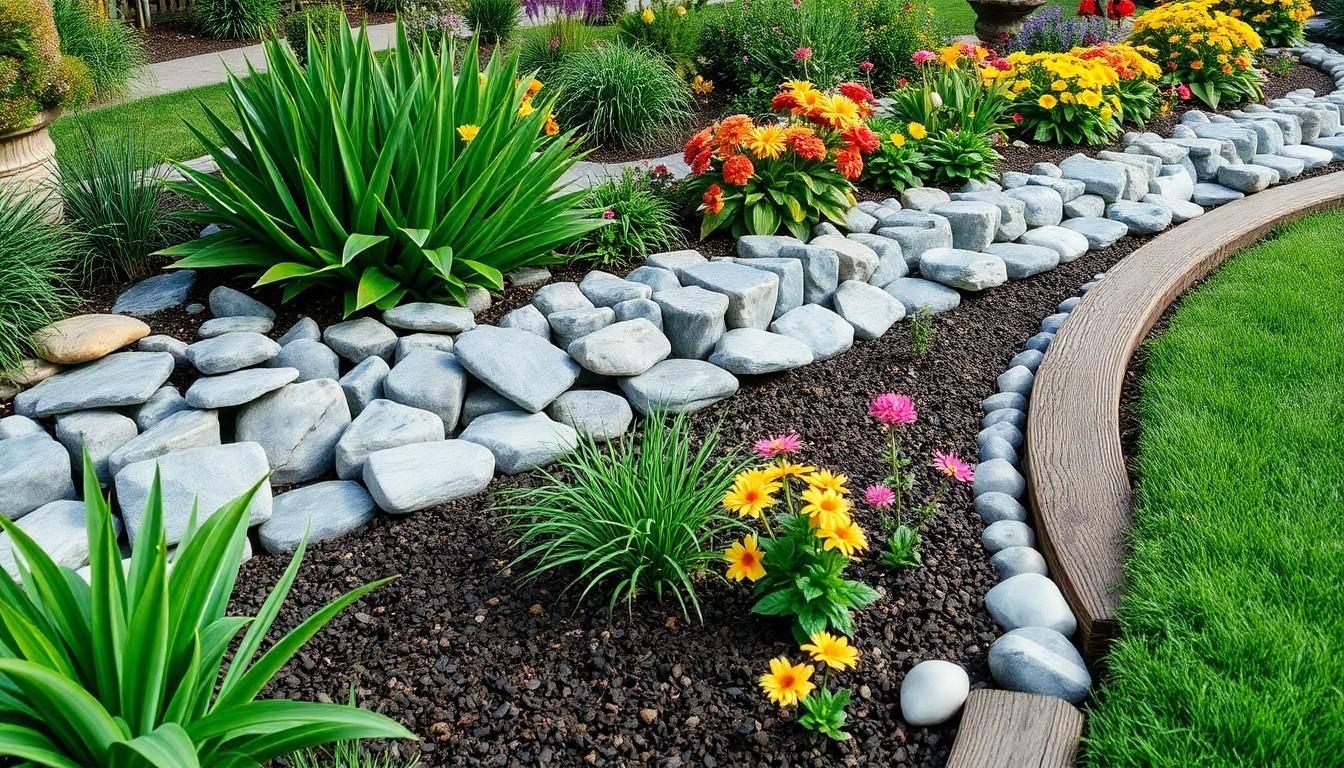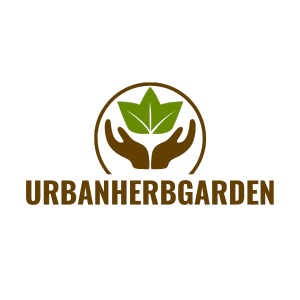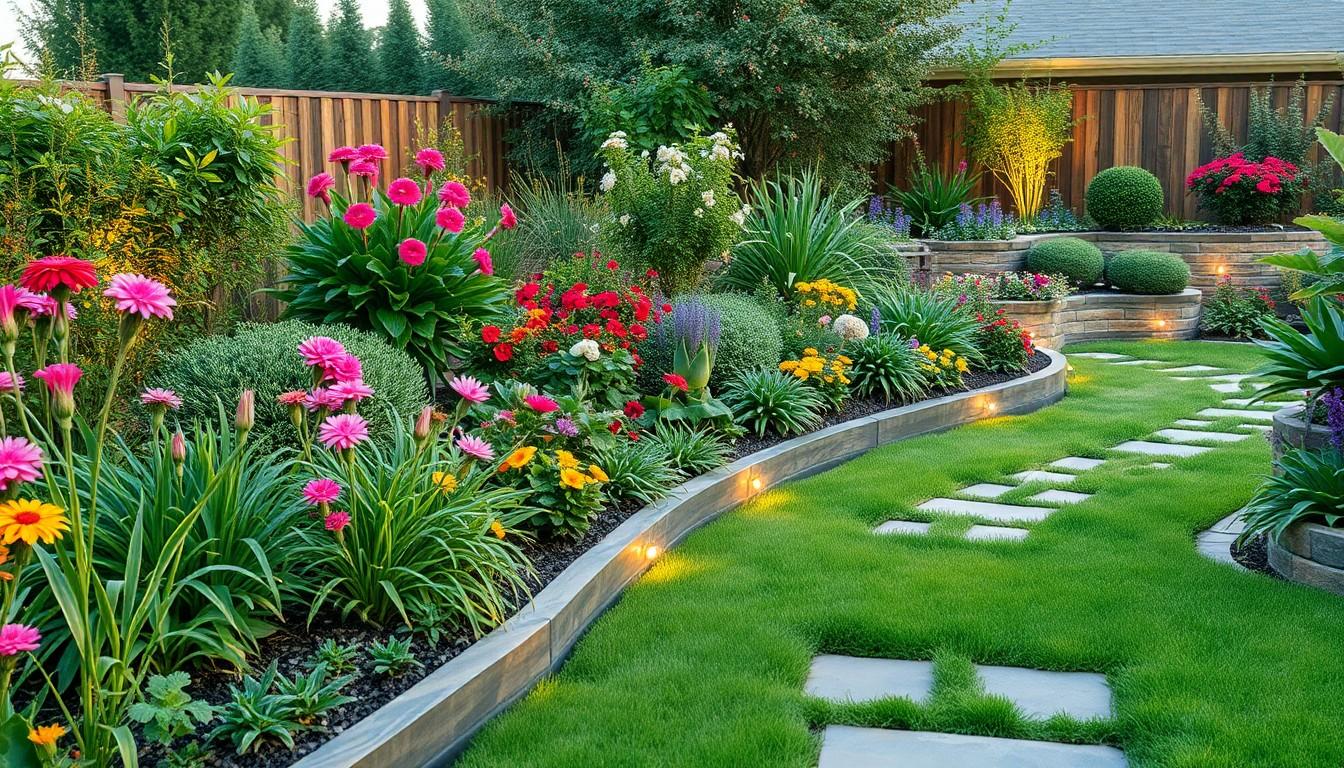A garden without proper edging is like a cake without frosting—sure, it’s still good, but it could be so much better! With the right garden edging, not only can you define your space but also add a splash of personality that’ll make your neighbors green with envy. Imagine strolling through your backyard oasis, where creativity meets functionality, and every border tells a story.
Creative Modern Garden Edging Ideas
Innovative materials can transform garden spaces. For instance, metal edging adds a sleek and contemporary look. Use corten steel for a rustic charm that develops a weathered patina over time.
Wooden borders serve dual purposes—functionality and aesthetics. Reclaimed wood creates a natural feel while helping to define plantings. Composite wood offers durability and low maintenance.
Consider using stone for a timeless appeal. Flagstone or brick pathways provide a stable boundary and charm. When arranged creatively, they deliver visual interest and a natural look.
Plants also serve as excellent edging. Low-growing shrubs or flowering plants act as living borders, softening transitions. Ornamental grasses offer texture and movement, enhancing the landscape’s overall feel.
Utilizing concrete or paving stones creates a polished finish. Concrete blocks or poured concrete form sleek lines and can withstand weather shifts. Paving stones add a decorative touch while remaining practical.
Decorative fencing offers unique options. Bamboo or lattice fencing can define spaces without hindering views. Add color by painting short fences to match existing garden elements.
Upcycled materials yield creative solutions. Old tires, glass bottles, or reclaimed bricks provide eco-friendly edging choices. These options offer distinct character while repurposing materials.
Finally, consider lighting in your edging design. Solar lights along borders highlight pathways and draw attention to features. Integrating lights adds safety and creates ambiance during evening hours.
Unique Materials for Edging

Creative edging materials enhance garden aesthetics while providing functional benefits. These unique options stand out and define personal style.
Stone and Rock Edging
Natural stone brings a rustic and timeless appeal. Flagstone and river rocks create distinct boundaries that blend seamlessly with garden landscapes. Adding stones in varying sizes adds texture and visual interest. Decorative gravel enhances the look and also aids drainage, ensuring healthy soil. Edging with large boulders offers an impressive focal point and durability against erosion.
Metal Edging
Sleek and modern, metal edging provides clean lines that complement contemporary gardens. Options such as steel and aluminum resist rust and corrosion, ensuring longevity. Minimalistic designs allow for flexible shapes and smooth transitions between garden beds and lawns. Additionally, metal materials reflect light, enhancing visual depth during the day. These edges create a polished look while presenting a low-maintenance solution.
Wood and Timber Edging
Wooden borders deliver warmth and a natural touch to garden spaces. Cedar and redwood resist decay, making them ideal choices for long-lasting edges. Various styles, including raised beds and simple stakes, accommodate different garden layouts. Incorporating reclaimed wood adds an eco-friendly vibe and unique character. It’s easy to paint or stain wooden edges, allowing for customization to match specific themes.
Design Trends in Garden Edging
Current design trends favor garden edging that balances aesthetics with functionality. Modern homeowners seek solutions that enhance their outdoor spaces while adhering to minimalist principles.
Minimalist Styles
Simplicity defines minimalist garden edging. Clean lines create a refined appearance, making space feel open and inviting. Materials like metal and concrete serve as popular choices; they emphasize form without overwhelming the landscape. Steel edges often provide a modern touch, while concrete borders offer durability. Select neutral colors to ensure compatibility with various garden styles. A smooth transition achieved through low-profile designs contributes to a cohesive look. By utilizing a monochromatic palette, the garden elements emerge more prominently. This approach aligns well with contemporary design philosophy, allowing nature to take center stage.
Curved Edging Designs
Curved garden edging introduces a dynamic flow. Unlike traditional straight lines, curves soften the overall appearance of outdoor spaces. Such designs guide the eye, leading viewers through the garden. Materials like flexible plastic or natural stone adapt easily to these shapes. A gentle curve creates natural pathways, enhancing interest and movement. Incorporating lush plants alongside curved borders adds dimension and texture. Soft edges feel inviting, making them perfect for family-friendly environments. These designs promote a sense of tranquility and harmony, essential for modern garden aesthetics. Curved edging supports the idea of connection, blurring the lines between different areas within the garden.
Functional Benefits of Garden Edging
Garden edging offers significant functional benefits that contribute to the overall health and organization of outdoor spaces.
Soil Retention
Soil retention plays a crucial role in maintaining a garden’s structure. Edging helps keep soil in place, preventing erosion during heavy rains. Defined borders create barriers that reduce the risk of soil runoff, ensuring essential nutrients remain in the planting areas. These borders also minimize the mixing of different soil types, which protects specific plants’ needs. Additionally, well-structured edging allows for effective water management by directing moisture to intended areas. With the right materials, such as stone or metal, this retention capability enhances garden longevity.
Pest Control
Pest control can be significantly improved with garden edging. Clear boundaries formed by edging serve as physical barriers, limiting access for common garden pests, such as slugs and snails. Specific materials, like wood or metal, can deter these unwanted visitors while adding aesthetic appeal. Furthermore, plants that border edges can attract beneficial insects, which help control pest populations naturally. By maintaining tidy borders, gardeners can monitor and manage pest activities more effectively, creating a healthier environment for plants to thrive.
DIY Garden Edging Projects
Creating unique garden edges enhances visual appeal and structure. Engaging in DIY projects provides hands-on satisfaction.
Step-by-Step Guides
- Metal Edging: Start with a metal strip, ensuring it is rust-resistant. Measure desired lengths, cut, and then drive stakes into the ground for stability. Maintain alignment for a sleek finish.
- Wooden Borders: Use decay-resistant wood like cedar or redwood. Cut planks to desired lengths, assemble them in place, and secure with stakes. This method enhances warmth and character.
- Stone Pathways: Select natural stone pieces or bricks. Lay them in a desired pattern, using gravel for stability. This approach provides a timeless look while defining borders.
- Living Borders: Choose plants like lavender or rosemary. Arrange them along the edge, ensuring they fit the garden’s style. Plants soften transitions while offering beauty.
- Upcycled Edging: Gather materials like tires or bottles. Position these creatively to form a unique border, combining eco-friendliness with charm.
Tips for a Professional Finish
First, ensure your edges are straight and even. Use a level when installing materials for precision. Next, regularly check plants for growth and adjust as necessary. Incorporate mulch to define edges clearly. Consider blending colors between edging and flowers for a harmonious look. Use lighting elements along the edges to create ambiance. Simple additions like solar lights enhance safety and aesthetics. Finishing with a consistent theme throughout the garden ties everything together neatly.
Organized Outdoor Environment
Creative modern garden edging ideas can truly elevate outdoor spaces. By choosing the right materials and designs, homeowners can create visually stunning landscapes that reflect their personal style. Whether opting for sleek metal or inviting wooden borders, each choice contributes to the garden’s overall charm. Incorporating unique elements like upcycled materials or living borders adds character while promoting sustainability.
DIY projects not only enhance aesthetics but also provide a rewarding experience. With careful planning and attention to detail, anyone can achieve a polished look that harmonizes with their garden’s theme. Ultimately, thoughtful garden edging not only enhances beauty but also supports a healthier and more organized outdoor environment.

